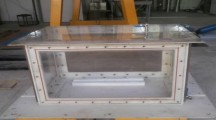Abstract
Based on the biological coupling theory, the resistance reduction characteristic of the surface morphology and surface wettability of the earthworm were studied in this paper. The parameters of surface dorsal pore and corrugation were extracted. According to these parameters, the lubrication mechanism of the earthworm surface was analyzed. The distribution of the pores and surface morphology were designed and the bionic coupling samples were prepared. The positive pressure, lubricant flow rate and advancing velocity were selected as the experiment factors while the soil friction resistance as observed object. According to the obtained data of bionic coupling samples from the testing system of biologic signal for tiny soil adhesion test, the optimal samples from the bionic coupling resistance reduction tests were selected through the range analysis. Compared to the normal ones, the soil resistance of bionic coupling samples was reduced by 76.8%. This is of great significance and offers bright prospects for reducing energy loss in terrain mechanics.
Similar content being viewed by others
References
Ren L Q. The progress of the research on terrain-machine bionics of reducing soil adhesion. Sci China Ser E-Tech Sci, 2008, 38: 1353–1364
Shelley T. Worms show way to efficiently move. Eureka, 2004, 24: 28–29
Ren L Q, Tong J, Li J Q, et al. Soil adhesion and biomimetics of soil-engaging components: a Review. J Agric Engng Res, 2001, 79: 239–263
Ren L Q, Wang Y P, Li J Q, et al. Flexible unsmoothed cuticles of soil animals and their characteristics of reducing adhesion and resistance. Chin Sci Bull, 1998, 43: 166–169
Tong J, Guo Z J, Ren L Q, et al. Curvature features of three soil-burrowing animal claws and their potential applications in soil-engaging components. Int Agr Eng J, 2003, 12: 119–130
Hendrick J G, Bailey A C. Determining components of soil-metal sliding resistance. T ASAE, 1982, 25: 845–849
Robbins D H, Johnson C E, Schafer R L. Modeling soil-medal sliding resistance. ASAE Paper, 1987, 87: 1580
Ren L Q, Yan B Z, Cong Q, et al. Experimental study on reducing adhesion in coal hopper by surface electro-osmosis. Chin J Mech Eng, 1999, 12: 152–159
Cong Q, Ren L Q, Chen B C, et al. Using characteristics of burrowing animals to reduce soil-tool adhesion. TASAE, 1999, 42: 1549–1556
Tong J, Ren L Q, Chen B C, et al. Characteristics of adhesion between soil and solid surface. J Terran Mech, 1994, 31: 93–105
Ren L Q, Han Z W, Li J Q, et al. Experimental investigation of bionic rough curved soil cutting blade surface to reduce soil adhesion and friction. Soil Till Res, 2006, 85: 1–12
Jia X. Unsmooth cuticles of soil animals and theoretical analysis of their hydrophobicity and anti-soil-adhesion mechanism. J Coll Int Sci, 2006, 295: 490–494
Yan Y Y, Zu Y Q, Ren L Q, et al. Numerical modeling of electroosmotically driven flow within the microthin liquid layer near an earthworm surface—a biomimetic approach. J Mech Eng Sci, 2007, 221: 1201–1209
Ren L Q, Han Z W, Li J Q, et al. Effects of non-smooth characteristics on bionic bulldozer blades in resistance reduction against soil. J Terramechanics, 2003, 39: 221–230
Perssona B N J. On the mechanism of adhesion in biological systems. J Chem Phys, 2003, 118: 7151–7164
Liu G M. Coupling Bionic research on the adhesion and resistance reduction of the earthworm surface. Dissertation of Doctoral Degree. Changchun: Jilin University, 2009. 27–30
Author information
Authors and Affiliations
Corresponding author
Rights and permissions
About this article
Cite this article
Li, J., Kou, B., Liu, G. et al. Resistance reduction by bionic coupling of the earthworm lubrication function. Sci. China Technol. Sci. 53, 2989–2995 (2010). https://doi.org/10.1007/s11431-010-4135-9
Received:
Accepted:
Published:
Issue Date:
DOI: https://doi.org/10.1007/s11431-010-4135-9




